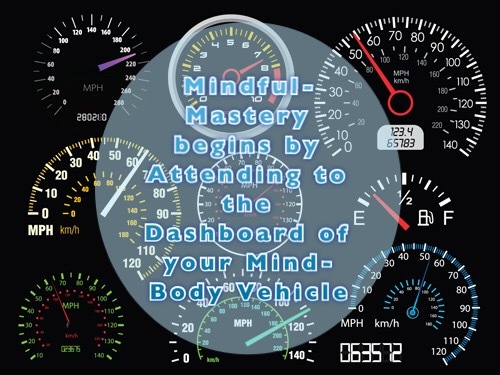
You know how it goes when you get triggered. Something happens, and before you know it, you are hooked. Pulled into an auto-pilot repertoire of thinking and behaving, which inevitably leads to a less than ideal outcome. These traps are extraordinarily difficult for us to catch in flight precisely because they are so quick and automatic.
We are all prone to this automaticity because the mind-body system is hardwired for habit formation. Your thinking and behavior habits get formed over time in two ways:
1.The action or mode of thinking is rewarding, in that it either increases pleasure or reduces discomfort.
2. The action or mode of thinking is practiced repeatedly.
Habits are Subtle Addictions
Of course, some forms of auto-pilot are more obvious. Addictions are the clearest examples of behaviors that are rewarding and can thus get practiced repeatedly. But just about any behavior or thinking pattern can become a habit (like a subtle addiction) if it meets the two criteria above.
Your more subtle habits can sneak up on you as insidious efforts to reduce discomfort, and derail you from your goals and values. But whether your habits are obvious, or less so, the first step in mastering them is hacking the system in which they reside!
Gaining Access to the Data.
The modern definition of 'hack' is to "use a computer to gain unauthorized access to data in a system." Hacking our habits means using your mind to access the unconscious reactions in your mind-body vehicle. Its basically learning to be mindful! In other words; intentionally bring attention and awareness to the components of your experience, in the present moment, non-judgmentally.
You know how sometimes you can loose your cool, or do something you later regret, and then wonder, "Why the heck did I do that?" Why did I have that extra drink?.. Sleep with that guy?.. Not prepare for that test?.. Stay up so late?.. Eat so much? Well, it is because you are human and somehow, that habit led to pleasure or reduced discomfort in that moment.
Learning to Read the Dashboard.
In previous blogs you learned a bit about your mind-body vehicle and how passengers get on board to influence your driving habits. The fist step in gaining control over your vehicle is learning to read the dashboard. This is the very first thing I teach my clients to do.
Dashboard Form
In the table above you can see a sample form, similar to the web-form I use with my clients. This form helps you to break down the components of your experiences. After several forms are collected, you begin to see what triggers (situations) elicit certain internal experiences (thoughts and feelings), which bring on the impulse to think or act (your habits) in a certain way to reduce uncomfortable experiences.
The Dashboard form is like Mindfulness on paper. It helps you to take a step back from your experience and more objectively look at a situation and your reactions. By completing this form you are essentially hacking into the automaticity of your habits!
Practiced regularly, this form can help you develop the much-needed insight into what triggers you, and how your habits function as a way of coping with passengers.
When to Complete the Dashboard Form.
The form should be completed in two types of situations:
- Whenever you are experiencing distress of some kind, and/or
- You find yourself avoiding, procrastinating, or otherwise not moving in the direction you would like to be going.
Distress and avoidance signal that something is going on, which needs your mindful attention. If it does not become immediately obvious to you when you should complete the form, try actively bringing to mind a goal you have yet to pursue or accomplish. Put this "brought to mind my goal of ...." in the situation box. Then complete the remainder of the form as directed below.
How to Complete the Dashboard Form.
In each box, choose a few words to label the following:
Situation: just the facts (the what, where and who) as anyone observing would agree.
Thoughts: the interpretations of the facts that went through your mind when you noticed the distress or avoidance.
Emotions: the emotional experience, using only single emotion words such as, angry, sad, anxious, lonely, ashamed, etc. Learn more about emotion labels and their functions here.
Bodily Sensations: the physical sensations in your body. Make sure that sensations are described in terms of a body part (e.g. pounding in my chest, sweaty palms, tightness in my shoulders), and not an idea or interpretation of a bodily sensation (e.g. I felt like my heart was going to jump out of my chest).
Impulses: the action or thought you are tempted to take to reduce your distress. Look for actions or thoughts that make you feel good, distract you, or somehow minimize awareness of the preceding boxes. This box is very important as it gives us clues to how we can get off track in our goals.
Building Self-Awareness.
You can make a simple table like this in a word document to use on your own. Complete this form as often as you can. Once you have about 10-12 of them, you should begin to see some patterns emerge. Look for the most common type of situation or experience to find your trigger(s) and vulnerable spots.
Self-Awareness is the first essential step in Mindful-Mastery. Hacking into your auto-pilot is the antidote to habit formation. It is not initially rewarding, and often painful to build our self-awareness. Like solving the great mystery of you; collecting evidence, and looking for clues. It takes patience and courage. But the awareness you build, will bring you closer to moving towards the long-term rewards of authentic living.
If you would like to learn more about auto-pilot habits and how to identify and change them, sign up for the Mindful-Mastery Skills Weekly here. Or follow me on Facebook, Twitter, or Instagram!

